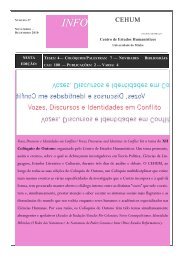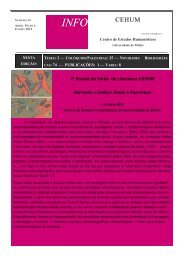Diacritica 25-2_Filosofia.indb - cehum - Universidade do Minho
Diacritica 25-2_Filosofia.indb - cehum - Universidade do Minho
Diacritica 25-2_Filosofia.indb - cehum - Universidade do Minho
You also want an ePaper? Increase the reach of your titles
YUMPU automatically turns print PDFs into web optimized ePapers that Google loves.
QUEEN CAROLINE AND THE PRINT CULTURE OF REGENCY RADICALISM<br />
175<br />
laughter. Th is fi ctional representation of the foibles of authority and of their<br />
ceremonial was an effi cient instrument in strengthening anti-establishment<br />
feelings.<br />
Hone also exploited the satiric potential of advertising, oft en in association<br />
with his satiric pamphlets. Advertisements Extraordinary (Hone, 1971:<br />
206-7), a number of mock advertisements in handbill format, [23] were sold<br />
together with Non Mi Ricor<strong>do</strong>. Th ey parodied all the protagonists at the<br />
Queen’s trial: the King (‘Strayed and Missing’), the Government (‘Th e Old<br />
Hakney, Liverpool’; ‘To Manglers – Just Leaving his Place’), and the Italian<br />
witnesses (‘To Laundresses, Wants a Place’). On the page opposite to the<br />
front-page of Non Mi Ricor<strong>do</strong>!, Hone advertised Th e Queen’s Matrimonial<br />
Ladder, and a ‘Lost Memory’:<br />
lost, at the Court martial, Signor my jockey’s memory, together with his<br />
Government Victualling Bill; both a little damaged, and of no use but to the<br />
owner. Whoever will bring them to the Publisher, in time to be restored to the<br />
Signor’s disconsolate Mother, Mrs. Leech, shall be rewarded with a “Non mi<br />
ricor<strong>do</strong>!” (Hone, 1971: 194)<br />
Th e theme of the press as a counter-power reappears in 1821 in Th e<br />
Political Showman – at Home! Exhibiting his Cabinet of Curiosities and Creatures<br />
– All Alive! (Hone, 1971: 269-97) and the newspaper parody A Slap at<br />
Slop and the Bridge-Street Gang (Hone, 1822).<br />
Th e Political Showman was inspired in freak-show advertising, a tradition<br />
featured in political propaganda since the Reformation. [24] Th e sevenheaded<br />
monster on the frontispiece represents the Holy Alliance, which<br />
together with the theory of the divine right of kings, was widely attacked<br />
by the radicals. In contrast to the monster, the Showman of the title is a<br />
humanised press, exhibiting ‘the most wonderful of all wonderful Living<br />
Animals’ of the ‘strangest and most wonderful artifi cial Cabinet in Europe<br />
[...] very crazy, but very curious’ (272).<br />
Th e originality of this satire lies in the presentation of the press as a<br />
human being, whereas politicians are ‘curiosities’ and aberrations. Hone<br />
23 Mock advertisements were published in varied formats, from handbills to pamphlets and even<br />
newspapers.<br />
24 Hone must also have resorted to his substantial collection and knowledge of the propaganda<br />
relating to elections, specifi cally to the 1784 Westminster campaign, whose ‘humours’ were<br />
compiled in Th e Wit of the Day, or Th e Humours of Westminster (Anon., 1784), a collection of<br />
advertisements, hand-bills, squibs, songs, ballads, etc. written and circulated during that election<br />
(Wood, 1994: 163, 180).<br />
<strong>Diacritica</strong> <strong>25</strong>-2_<strong>Filosofia</strong>.<strong>indb</strong> 175 05-01-2012 09:38:28



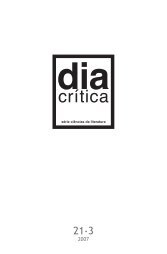

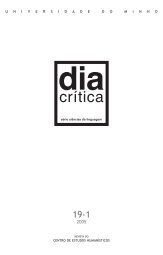



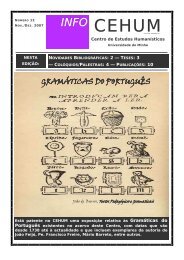

![Programa [pdf] - cehum - Universidade do Minho](https://img.yumpu.com/17305425/1/190x135/programa-pdf-cehum-universidade-do-minho.jpg?quality=85)


